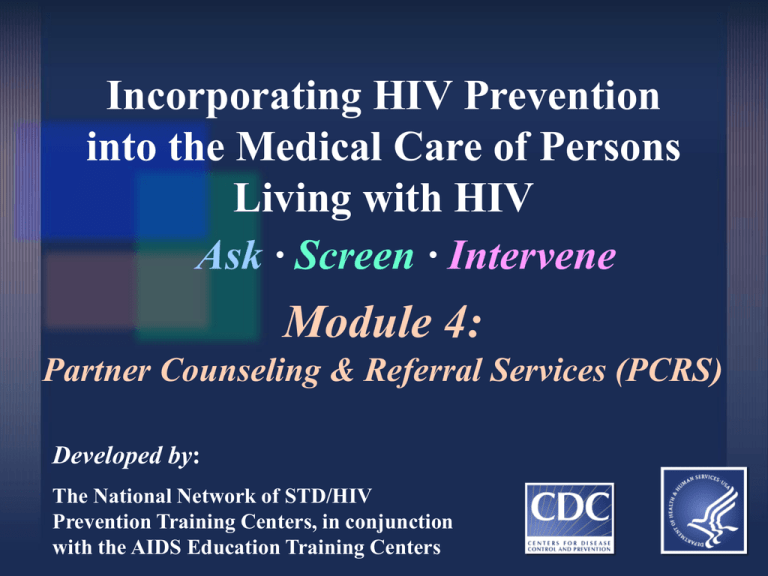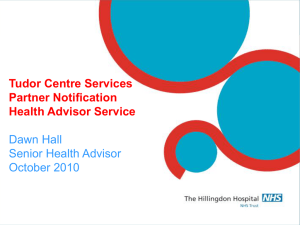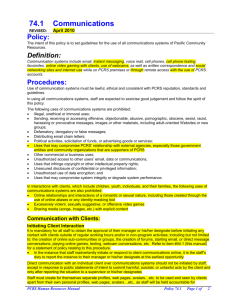
Incorporating HIV Prevention
into the Medical Care of Persons
Living with HIV
Ask ∙ Screen ∙ Intervene
Module 4:
Partner Counseling & Referral Services (PCRS)
Developed by:
The National Network of STD/HIV
Prevention Training Centers, in conjunction
with the AIDS Education Training Centers
Quick Poll
What comes to mind
when you hear the term
partner notification?
Recommendations
for HIV PCRS
At the initial visit, ask patients if all of their
sex and needle-sharing partners have been
informed of their exposure to HIV
At routine follow-up visits, ask patients
about new sex or needle-sharing partners
who have not been informed of their
exposure to HIV
Recommendations for
HIV PCRS
All patients should be referred to the appropriate
health department to discuss partners who have
not been informed of their exposure and to
arrange for their notification and referral for HIV
testing.
In HIV health-care settings, access to available
community partner counseling and referral
resources should be established
Learning Objectives: Module 4
Upon completion of training, providers who care for
HIV-infected persons will be able to:
Define
Partner Counseling and Referral
Services (PCRS).
Explain the importance of PCRS in relation
to HIV.
Initiate discussion of the 4 partner referral
options.
Breaking the Chain of Infection
Clinical
Management
Behavioral
Counseling
Partner Services
• Make no assumptions
• Ask specific questions
• Maintain tact and respect
• Identify and correct misconceptions
• Use open-ended questions • Tailor the intervention
• Routinely integrate into clinical encounters
Learning Objectives: Module 4
Upon completion of training, providers who care for HIVinfected persons will be able to:
Define
Partner Counseling and Referral
Services (PCRS).
Explain the importance of PCRS in relation to HIV.
Initiate discussion of the four partner referral options.
What is HIV Partner Counseling
and Referral Services (PCRS) ?
HIV Partner Counseling and Referral Service:
Is a voluntary and confidential service
Assists persons living with HIV to tell their
partner(s) about possible exposure
Facilitates linkages to services.
Is not widely available in Pacific jurisdictions
Learning Objectives: Module 4
Upon completion of training, providers who care for HIVinfected persons will be able to:
Define Partner Counseling and Referral Services (PCRS).
Explain the
importance of PCRS in relation
to HIV.
Initiate discussion of the four partner referral options.
Rationale for HIV PCRS
HIV PCRS provides an opportunity to:
Interrupt
disease transmission and prevent
complications
Provide counseling and education for reducing
behavioral risks that increase the risk of
STD/HIV transmission
Provide access to testing and other prevention
services
Partner Counseling, Testing, and Referral in
Ten States* with Highest Reported HIV/AIDS
Cases in 2002
14,042 partners elicited through PCRS
52 % (of those partners not previously
known to be HIV+) were tested
18% of those were newly-identified
HIV+
*California, Florida, Illinois, Louisiana, New York, New Jersey, North Carolina,
Pennsylvania, Texas, Virginia
Key Benefits to Patients
and Partners
Common
Concerns
Patient may not have to
reveal HIV/STD status
Threat to
confidentiality
Fulfills ethical desires for
patient
Partner learns information
about real risk
Intervenes in spread to other
partner(s) or unborn children
Potential for
violence,
especially against
women, when
HIV+ serostatus
is revealed
Stigma-related
discrimination
Key Benefits to
Clinicians
Common
Concerns
Fulfills public health and Threat to
ethical concerns
confidentiality
Increased work load in
a time-limited
environment
Unclear legal
expectations
Can be performed by
non-clinical staff
Federal Regulations: Ryan White
CARE Reauthorization Act
Requires that health departments
receiving Ryan White funds show
“good faith” efforts to notify marriage
partners of infected patients.
“Real Life” Scenario
Tapu is a 35 y.o. married man with four children
Travels often for business, away for several weeks
at a time
Frequently has sex with “massage parlor women”
on Guam, and has several other occasional female
partners on other islands; inconsistent condom use
Returns from a trip with mild penile irritation,
comes into the clinic to be checked out
No abnormalities noted on exam; GC culture,
syphilis test and HIV sent
“Real Life” Scenario
Follow-up: GC
culture negative, syphilis
negative, but HIV positive!
Instructed to not have sex with his wife, or
to use condoms with her, until confirmatory
test comes back
Two weeks later, confirmatory test comes
back positive; Tapu has had sex with his
wife several times without a condom
“Real Life” Scenario
What
are your legal obligations in
informing the partners?
How would you talk to Tapu about
informing his wife?
How would you handle informing the
occasional partners on the other islands?
What if Tapu refuses to inform his partners?
Learning Objectives: Module 4
Upon completion of training, providers who care for HIVinfected persons will be able to:
Define Partner Counseling and Referral Services (PCRS).
Explain the importance of PCRS in relation to HIV.
Initiate
discussion of the four partner referral
options.
How to Bring Up the Subject of
Partners
“Now that we’ve talked about ways to keep
you healthy, let’s talk about ways to keep
your partner(s) healthy. How do you feel
about telling your partner(s) they’ve been
exposed to HIV?”
Sample Transitional Phrases
Partner Management Options - At a Glance
Type of Referral Option
Who notifies and refers this partner?
Provider or PCRS
Referral
PCRS counselor, provider or clinic
staff
Patient Referral
Patient with coaching from
provider
Patient makes initial attempt; if
unsuccessful, PCRS provider or
clinic staff conducts referral
Contract Referral
Dual Referral
Patient agrees to disclose HIV
Status with provider present
Four Referral Options Handout
Provider or PCRS Referral
Often clinicians do not have sufficient time or
training for PCRS
A PCRS counselor or trained clinic staff can:
o Talk with your patients to identify partners
and determine notification strategy
o Perform the notification
o Help other providers learn how to elicit and
establish notification plans for each partner
PCRS Programs
Trained and
experienced staff provide PCRS
and other STD related counseling services in
both field and clinic settings
No
information about your patient is given to
the partner
Immediate notification of
partners (usually
within 24-48 hours)
Relieves
you and your staff from those duties.
How Health Departments Protect Confidentiality
What if We Don’t Have a PCRS
Program?
Clinicians or clinic staff who wish to
perform PCRS should know:
CDC
recommends in-depth standardized HIV
PCRS training course(s) with subsequent
mentoring and technical supervision by
experienced supervisor.
CDC HIV PCRS Guidelines (1998) and Interim
Technical Guidance (2004) for Advancing HIV
Prevention: HIV PCRS Interventions
Patient Referral
The
infected patient agrees to inform partners
of their possible exposure and refer to
appropriate services.
Persons
initially prefer to inform their
partners themselves, although, many clients
often find this more difficult than anticipated.
Notification by
PCRS staff seems to be
substantially more effective than notification
by the infected person.
(CDC MMWR 2003)
Patient Referral
Patient should assess own willingness & ability to:
Disclose own HIV status
Accept that partner is not bound to protect confidentiality
Contact partner promptly
Find a private place for discussion
Help partner understand seriousness of HIV
Refer the partner for services
Anticipate and handle partner’s reactions
Follow-up to confirm notification occurred and to make
alternate plan when necessary is ideal patient care and should
occur when ever possible.
PCRS Plan and Coaching
What if the Patient Wants to Inform the
Partner Without Revealing His/Her
Identity?
Not an ideal situation, however possible if no
other options
Can use a referral card, which may be mailed to
partner or dropped off at the house
Instructs recipient to present to local clinic for
evaluation because of exposure to communicable
disease
Use a code recognizable by providers on all
islands, indicating exposure to HIV
Model for Referral Card #1
Card No. ____________________
Card No. ________
Date of
Issue: _______________________
Issuing Clinic: Townville, New Town
Date of Issue: ________________
Name: ___________________________________________
Diagnostic
Code: _______________________
Partner’s names and details:
____________________________
____________________________
Our address,
telephone number and
office hours are
listed on the reverse side.
Clinic: ______________________
Townville, New Town
Diagnostic code: ___________
Model for Referral Card #2
TOWNVI LLE CLI NI C
Center Street at corner of Crossing Alley
Townville, Newtown
Tel. No.: 123 - 456
OFFICE HOURS:
Monday
9.00 am to 3.00 pm
Tuesday
9.00 am to 9.00 pm
Wednesday
9.00 am to 3.00 pm
Thursday
9.00 am to 9.00 pm
Friday
9.00 am to 3.00 pm
4/3/97
UD
Contract Referral
The infected person has mutually agreed upon a set
time period (usually a few days) to notify his or her
partner(s).
If by the agreed date, the partners have not been
notified of possible exposure and of the need for
counseling and testing, they are confidentially
contacted by clinic staff
Dual Referral
The infected person elects to notify their partner(s)
in the presence of the provider
The patient understands he/she is waiving their
right to anonymity
Typically done in a clinic or office setting
A discussion around boundaries and session
management is required prior to meeting with
partners
Tapu
Tapu
initially says he wants to inform his
wife himself (patient referral)
At the next clinic visit, he admits he has not
done so
He agrees to find a good time to inform her,
and if he is not successful within the next
week, he agrees to let the provider inform
her (contract referral)
Tapu, the Next Week
Tapu has still not informed his wife
He doesn’t want clinic staff going to his house, but
he agrees to bring his wife in to the clinic and
inform her in the presence of the provider (dual
referral)
She comes with him to clinic the next visit, and
agrees to have HIV testing
Tapu refuses to reveal the names or locations of
his occasional partners on other island, but agrees
to send them referral cards
Tapu, Continuing Follow-up
Tapu’s wife tests negative initially, and is still
negative on repeat testing 3 months later
No need to test the children since the wife is
negative
Tapu is doing well, and continues to come to the
clinic every 3 months for follow-up
6 months after his diagnosis, he is asked again
about other sex partners
He admits to still having contact with one of his
previous partners, but says she has been tested and
they are using condoms 100% of the time
Additional Resources
Local Health Department HIV/AIDS Programs –
http://www.cdc.gov/nchstp/dstd/Public_Health_dept.htm
National Alliance of State and Territorial AIDS Directors (NASTAD) –
www.nastad.org
Advancing HIV Prevention: Interim Technical Guidance for HIV
Partner Counseling and Referral Services (Centers for Disease Control
and Prevention) www.cdc.gov/hiv/partners/Interim/partnercounsel.htm
State STD Program Managers – see handout
National Coalition of STD Directors – www.ncsddc.org
HIV Criminal Law and Policy Project - www.hivcriminallaw.org
STD HIV Prevention Training Center – Partner Management and
Program Support Services Training –
www.stdhivpreventiontraining.org
STD Program Managers Handout and Resource Handout







